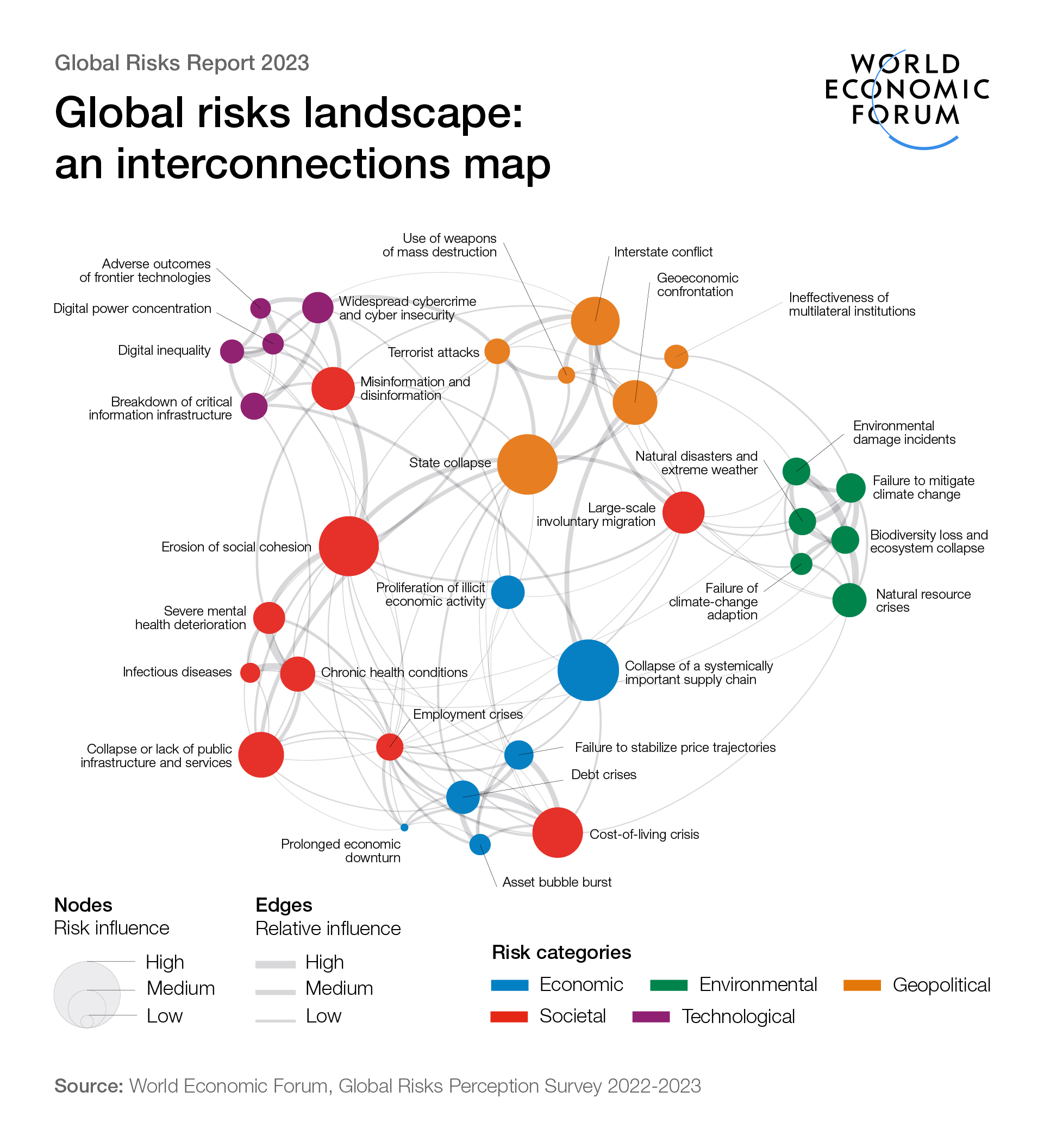These are the biggest risks facing the world

The Global Risks Report 2023 warns of interconnected risks leading to polycrises. Image: REUTERS/Jose Luis Gonzalez

Get involved with our crowdsourced digital platform to deliver impact at scale
Stay up to date:
Davos Agenda
Listen to the article
- The World Economic Forum's latest Global Risks Report identifies the key risks facing the world over the next decade.
- In the next two years, the cost-of-living crisis is seen as the biggest risk, while over the next 10 years environmental risks dominate.
- The interconnectedness of global risks and crises is giving rise to the threat of 'polycrises' in the years ahead.
- Hear the Radio Davos podcast. And watch the press conference.
The 2020s have gotten off to a disruptive start.
From COVID-19 to war in Europe - as the World Economic Forum's Global Risks Report 2023 explains, these have ushered in a "fresh series of crises in food and energy - problems that decades of progress had sought to solve".
As a result, this year's report presents a set of risks that are both familiar but also feel new. In particular, the return of risks like inflation, cost-of-living and geopolitical confrontations are historically nothing new, but for the current generation of policy-makers and business leaders they're unfamiliar.
So, what are the biggest risks the world is facing?
Have you read?
The biggest short- and long-term risks
The report uses data from the Global Risks Perception Survey 2022-2023 to understand the risks the world is likely to face over the coming 10 years.
The survey identifies the cost-of-living crisis as the most severe threat facing us over the next two years. Next is natural disasters and extreme weather events while geoeconomic confrontation also features in the top 3 most severe risks in our most immediate future.
Contrast this to a 10-year view and the long-term risk of failure to tackle climate change emerges as the biggest set of risks. From failure to mitigate climate change to biodiversity loss and ecosystem collapse, the top 4 most severe risks over the next 10 years are all environmental. Indeed, the cost-of-living crisis drops out of the top 10 entirely, while geoeconomic confrontation drops to 9.
“The short-term risk landscape is dominated by energy, food, debt and disasters. Those that are already the most vulnerable are suffering – and in the face of multiple crises, those who qualify as vulnerable are rapidly expanding, in rich and poor countries alike. Climate and human development must be at the core of concerns of global leaders, even as they battle current crises. Cooperation is the only way forward,” said Saadia Zahidi, Managing Director, World Economic Forum.
The risk of polycrises
The year's World Economic Forum Annual Meeting in Davos will reflect the number of ongoing crises. As the meeting overview explains: "The world today is at a critical inflection point. The sheer number of ongoing crises calls for bold collective action."
And, it's the interconnected nature of these crises and risks that this year's Global Risks Report calls out as a particular danger. "Concurrent shocks, deeply interconnected risks and eroding resilience are giving rise to the risk of polycrises - where disparate crises interact such that the overall impact far exceeds the sum of each part," its authors write.

This year's report explores four potential futures for 2030 around resource rivalry and the polycrises that could emerge as a result of competition for natural resources - competition driven by interrelated environmental, geopolitical and socioeconomic risks.
You can read more about resource competition, resource collaboration, resource control and resource constraints in the report.
Don't miss any update on this topic
Create a free account and access your personalized content collection with our latest publications and analyses.
License and Republishing
World Economic Forum articles may be republished in accordance with the Creative Commons Attribution-NonCommercial-NoDerivatives 4.0 International Public License, and in accordance with our Terms of Use.
The views expressed in this article are those of the author alone and not the World Economic Forum.
The Agenda Weekly
A weekly update of the most important issues driving the global agenda
You can unsubscribe at any time using the link in our emails. For more details, review our privacy policy.
More on Davos AgendaSee all
Kate Whiting
April 17, 2024
Andrea Willige
March 27, 2024
Shyam Bishen
March 20, 2024
Simon Torkington
March 15, 2024
Miranda Barker
March 7, 2024






